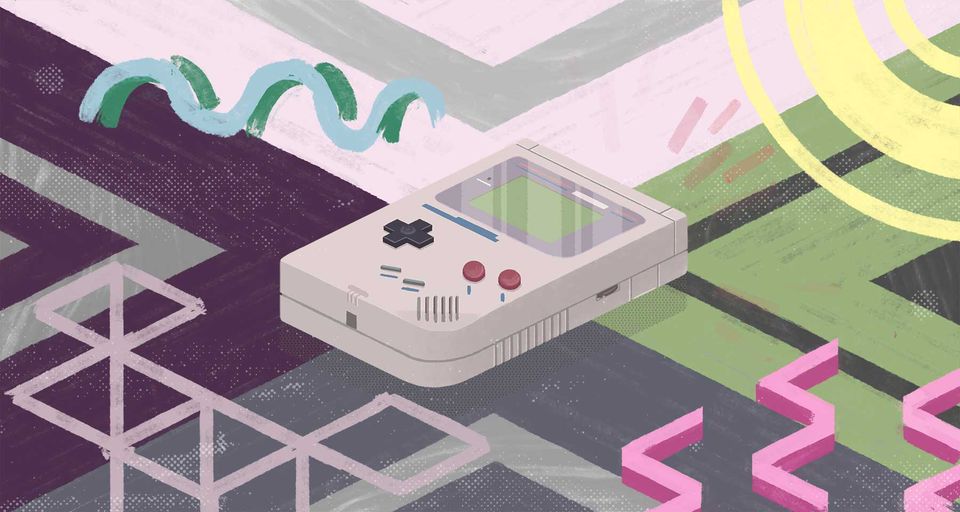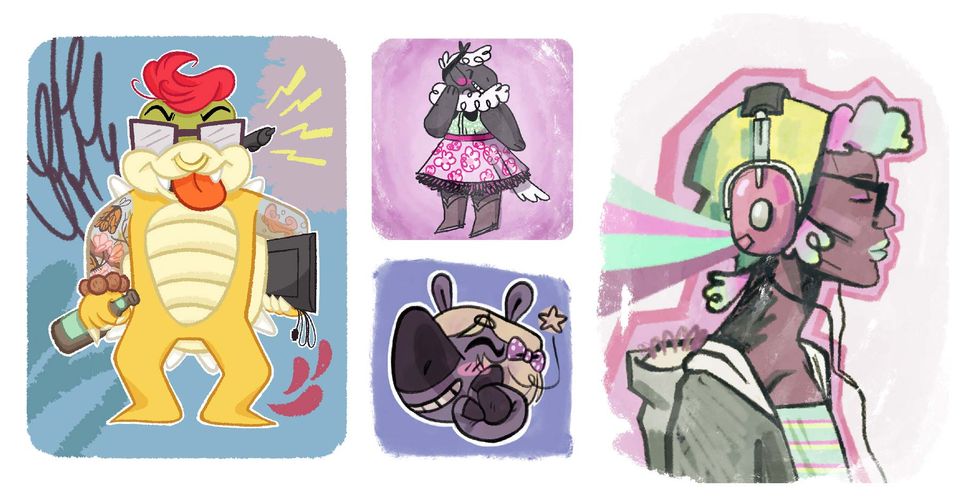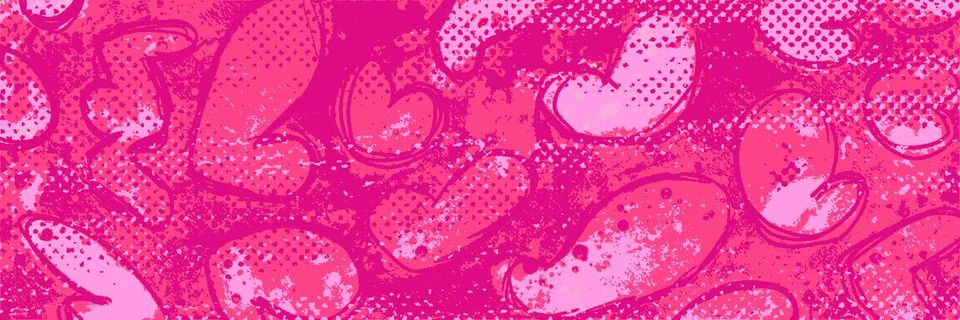Artist Spotlight: Dale O'Flaherty
February 25, 2020
Everyone’s work is deeply idiosyncratic: in our regular Spotlight segment we explore artists’ experiences and inspiration to understand what defines and inspires their unique styles.
Can you give us a brief background on yourself?
I've always been drawing from a very young age but it was never something that I thought of pursuing as a career, so I didn't study art or design in college. I actually have a degree in Science. It was during my undergrad that I kind of got back into drawing and making art. I was reading a lot of webcomics at the time and became aware of a community of artists who were making autobio comics on LiveJournal. I decided to make some of my own and to my surprise people quite liked them. I eventually ended up getting a Wacom tablet for myself as a graduation present (before this I was just drawing the comics in a sketchbook and then scanning them in). I don't think I was even colouring my comics at this stage I had very little idea of how I would go about doing that. I remember sending an email to James Kochalka (best known for his long running daily diary comic series American Elf) asking him if he used different colour inks for his lines because I didn't realise that you could change the colour of your inks after you'd scanned them in. So, I got myself a Wacom tablet and set about teaching myself how to use graphic design software. At the time I was using a program called PaintTool SAI, which is a cheap lightweight painting program. It's actually still quite popular among young artists, and people are still making incredible work with it. I used Manga Studio for a little while afterwards, but now I use Adobe Photoshop for pretty much everything. I was really intimidated by Photoshop and avoided trying to learn how to use it for quite some time, but the shortcuts are quite similar to Manga Studio so it wasn't as scary to learn as I thought it would be. I did do a diploma course in graphic design to get some formal adobe suite training and I did a fine art course for all of about 3 months, but besides that I’m more or less entirely self taught.

What kind of influence does your location have on your career?
Since I'm not formally trained in art or design I don't feel like I have a lot of connections in the Irish design community. Most of my friends and peers live overseas. I know only a handful of Irish artists personally. There are good and bad aspects to this. I feel richer for having access to people of a wide variety of backgrounds and I feel like this has made me a better artist, and a more thoughtful person. But also, I definitely feel very disconnected from the local arts scene.
What is your process like when combining traditional and digital methods?
I generally use my sketchbook to figure out what I want to communicate first before I go into Photoshop. For whatever reason, it feels more natural for me to iterate through different ideas and concepts on paper. But recently, I’ve been experimenting with colouring sketches digitally that feels like a good mix of both methods. I will sketch something out then take a picture of it with my phone then bring it into Photoshop. I usually mess with the levels a bit to make it a bit brighter. Then I’ll just paint on top of it and mess with layer blending modes and adjustment masks until I have something that I’m happy with.
Could you pick one piece of art that has made a lasting influence on you, and if so why?
Probably the aforementioned American Elf by James Kochalka. He would sit down every day and make a comic about what happened that day, and he did that every day for 14 years. Often his comics were about very mundane things, but they would still be really funny and beautiful. It made the act of making comics very approachable. As far as other artists that influence me, I’m a big fan of Pseudonym Jones, Laura Knetzger, Tom Eccles, Maris Wicks, Sarah Sobole, kittenpillar, Allie Mehner, weja, Sam Davies, Lottie Pencheon, titas antanas vilkaitis, Anna Syvertsson... I love artists that make very bold, clean, and chunky art with interesting shapes and textures.
What skills or techniques are you working to try improve at the moment?
I spent a long time thinking that my art needed to be more figurative to be better (I guess because of insecurity over being self taught), and it was making art really unenjoyable, time consuming, and stressful to make and there would be long periods of time where I just wasn’t able to make anything. So, what I’ve been working on is changing how I approach my work and making it more enjoyable, because it wasn’t for the longest time. So, I’ve been making fan art, doodles, and other really goofy self indulgent things. I’ve also changed up my process a lot, I’m trying to be much looser and more experimental in how I do things and I’ve found that’s helped as well.
Can you give our readers a tip or trick you have come across that has made your work a lot easier?
I’d say not to be afraid of experimenting and playing around. Half of my favourite pieces come from just messing around and not worrying about the subject matter or the final image/product. You can always use those techniques you learn on weird experimental doodles later in bigger pieces. No time is wasted if you’re learning something. If I wanted to give some practical advice I would say use adjustment layers and always keep backups of your files. Also, if you use Photoshop I'd highly recommend Lazy Nezumi's
brush smoothing plug in. As well as, any set from Kyle Webster's brush shop.
How can people who are interested in discovering more of your work find it?
My Tumblr is where I post my finished pieces, but I post most of my doodles to Instagram and Twitter and they are both more regularly updated.
Scriba is a revolutionary digital stylus that is ergonomically designed to comfortably fit your hand and uses unique Squeeze-Motion technology. Order here.
Articles

In the period since COVID forced many of us back home and out of the office, remote work has become the new norm for many. The flexibility of working from home, especially for those with small children, is very compelling, but making a productive workspace is more than setting up a desk in the spare room. More people are seeking to create functional and comfortable workspaces in their homes, however, it can be difficult to strike the right balance between a professional office space and a cosy home environment. Here are some tips for designing a home workspace that meets both of these needs: Dedicate a specific area for work Designating a specific area for work is essential for separating work from leisure time. This could be a separate room or just a corner of a room. It is important to make sure that the workspace is free from distractions and clutter, as this will help you stay focused and productive. Choose the right furniture Ergonomic furniture is key to a comfortable and productive workspace. Invest in a comfortable chair, a desk that is the right height, and a good-quality mouse and keyboard. If you are prone to back pain, consider a standing desk. Add personal touches Just because your workspace should be functional, doesn’t mean it can’t be personal. Add photos, plants, and other personal items to make the space feel like your own. This will help create a sense of comfort and make you feel at home in your workspace. Good lighting Good lighting is essential for a comfortable workspace. If possible, place your desk near a window for natural light. If not, invest in a high-quality desk lamp to provide bright, even light. Keep it organised An organised workspace will help you stay productive and focused. Use desk organisers, filing cabinets, and other tools to keep your work area free from clutter. A clean and organised workspace will also help you start each day with a clear mind. Consider your work style Think about the type of work you do and how you like to work. If you prefer a minimalist workspace, opt for a simple desk and a few basic supplies. If you need space for multiple screens and other technology, make sure you have enough room to work comfortably. Take breaks It’s important to take breaks throughout the day to avoid burnout. Step away from your desk, go for a walk, or do some stretching exercises to clear your mind and recharge.












